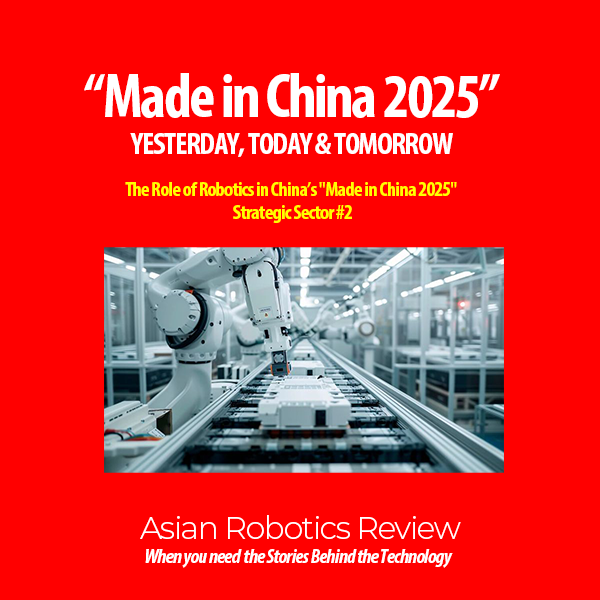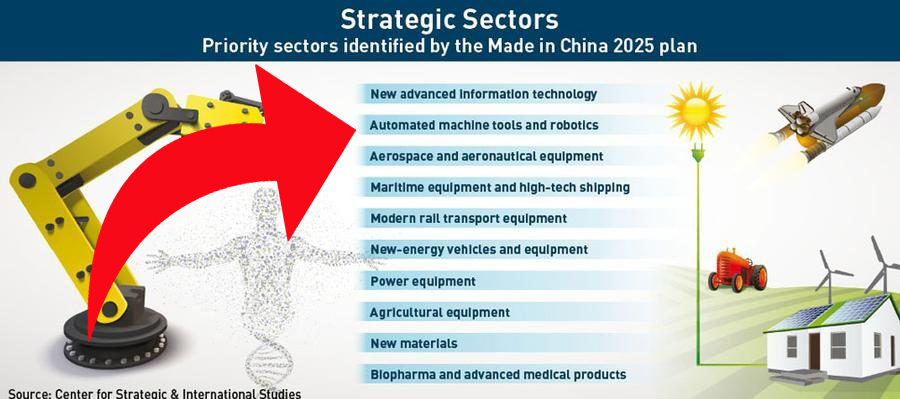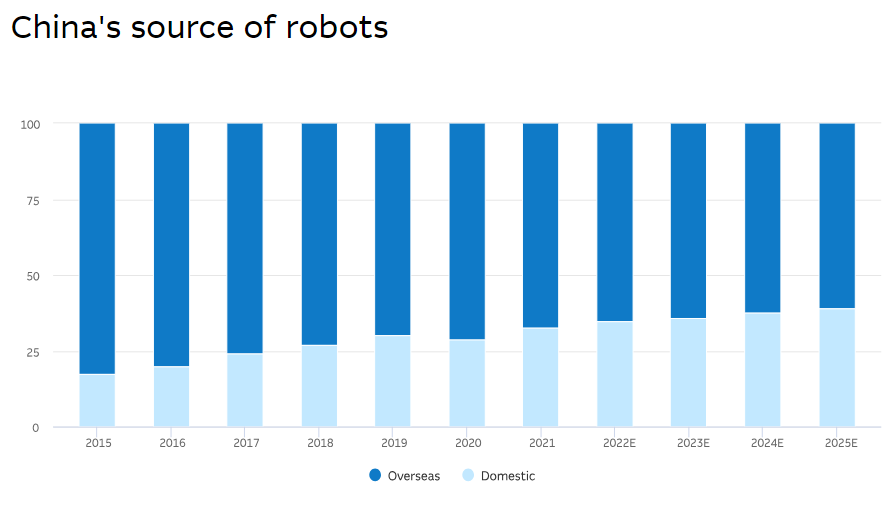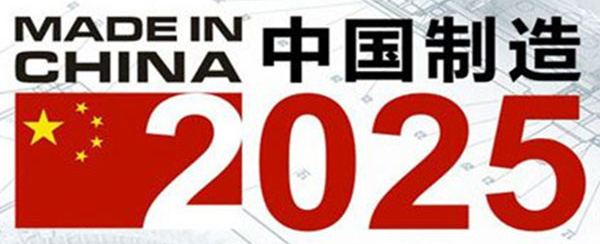
YESTERDAY, TODAY & TOMORROW
"Made in China
2025"
The Role of Robotics
Yesterday
China’s ambitious “Made in China 2025” plan, initiated in 2015, set out to position the country as a leader in advanced manufacturing, covering ten strategic sectors, including robotics (which is #2 on the chart below).
After nearly a decade, the overall ten areas targeted by “Made in China 2025” have had their share of detractors, like Lee Branstetter, professor of economics and public policy at CMU’s Heinz College: “There was little evidence of increases in productivity, R&D expenditures, patenting, and profitability.”
Or, those on the other side like this recent Bloomberg piece, Almost 10 Years Later, China’s ‘Made In 2025’ Has Succeeded. Bloomberg cites China’s successes in EVs, solar, and semiconductor production, 5G, commercial airlines, shipbuilding, artificial intelligence (AI), automation and robotics, many of which came into prominence over the decade 2015-2025. All the while, China was still juggling advances in aerospace, high-speed railways, and medicine, as well as massive civil engineering projects like dam building and the reclamation of vast stretches of desert. Not to mention the big kahuna, its Belt & Road Initiative.

Here at the end of 2024, who else on the planet has taken on such a bold, national plan? No one! Deng Xiaoping, the country’s former leader, was fond of saying that his people were at their best when taking on such colossal projects. Or, as he put it: “The only hard truth is development.” Maybe he was right. He died in 1997, a dozen years before “Made in China 2025” kicked off its massive undertaking.
Automated machine tools & robotics, #2 on the Strategic Priorities list (see chart) for “Made in China 2025” was one of the most prized by China because it was the hoped-for realization that could shift manufacturing from low-quality goods to higher-value products and services, making China a global leader in high-tech manufacturing.

Seems the developed world wasn’t overly anxious for China to arise to such an exalted level. It could continue to produce gazillions of Barbi Dolls or assemble boatloads of $700-dollar iPhones at four bucks a pop, but don’t you dare to aspire to leadership in high-tech manufacturing, which was the exact purpose of “Made in China 2025”. Somewhere nearby, Deng Xiaoping was nodding with a big smile.
Domestically produced robots and robot-driven automation, developed, produced, and deployed by China, in China were the keys to success. Industrial robots were readily recognized as pivotal elements of China’s ambition to become a high-tech manufacturer and escape the middle-income trap of slow growth, stagnant or falling wages, and an economy lacking a bright future. Japan and Korea had barely escaped the trap. Shouldn’t China be the next East Asian country to succeed? With “Made in China 2025” industrial robotics received greater political support and public attention than any other manufacturing technology in China.
Feeling for the stones
In regard to building out a Chinese, domestic robot capability, “Made in China 2025” (announced in 2015), is part of an ever-expanding series of government announcements on robotics going back to the 12th Five-Year Plan (2011-2015), under the heading 12th Five-Year Plan for the Development of Intelligent Manufacturing Technology. Two years later (2013), China became the largest buyer of industrial robots in the world, and still is. That was followed by Guidelines on Promoting the Development of the Industrial Robot Industry, in 2013. Then came Xi Jinping’s now-famous “robot revolution” speech, making the nation’s leader its foremost promoter and thus opening the floodgates for powerful financing options.
A year later, 2015, out pops “Made in China 2025”, then the Robotics Industry Development Plan (2016-2020), followed by the Robot + Application Action Plan that outlined the development of the industry (2023). In all, the decades-long process was like Deng Xiaoping’s frequent transformation quote of crossing the river by feeling for the stones.
SEE ALSO:“Development is the only hard truth.”—Deng Xiaoping
China Back in Business with Industrial Robots
Today: Then came China’s robots
With billions of dollars from direct and indirect financial support and grants from the central government and provincial governments, as well as low-cost loans, and assistance from China’s SOEs (State-Owned Enterprises), “Made in China 2025” (from 2013 to 2024) succeeded in standing up a credible robot industry as well as, by association, 10 high-quality cobot manufacturers. Collectively China’s Indigenous robot brands now account for 35% of all robot sales and deployments in China, up from 15% in 2015, but far off from the targeted, but unrealistic, 70%
And they are gaining in popularity! The three biggest brands: Siasun Robot & Automation, Estun Automation, and EFORT Intelligent Equipment.
The popularity of domestically manufactured industrial robots in China can be attributed to a combination of cost competitiveness, innovation, and government policies favoring domestic suppliers. These brands compete not only against each other but also with well-established international robotics companies. Domestic manufacturers like Siasun, Estun, and EFORT have carved out significant market share by offering tailored solutions and addressing the unique demands of the Chinese manufacturing landscape.
M&A activity and international partnerships have helped out immeasurably, especially for Estun, which has acquired German, Italian, and American robot technology. And let’s not forget appliance maker Midea’s acquisition of German robot star, KUKA, for $5 billion.
All of that and more will be needed to upgrade market share beyond the current 35%. China is by far the largest industrial marketplace in the world with over 1.7 million industrial robots already deployed. With a vast market still to go: China’s Blue Book claims that the country has over 1.5 million factories and over 2 million warehouses, with the vast majority still unautomated.
China industrial robots market size was valued at $3.42 billion along with volume of 266.4 thousand units in 2022, and is projected to grow at a CAGR of 12.6% through 2030.
The domestic market continues to expand as industries seek to modernize production lines to boost efficiency and mitigate labor shortages. Additionally, with advancements in AI and machine learning integration, Chinese robot manufacturers are increasingly capable of producing intelligent, high-precision machines that enhance productivity across various sectors.
“The ambitious state-driven plan to retool China’s industries to compete in areas like automation, microchips and self-driving cars— is not being pushed just by the Communist Party’s top leaders. Instead, the drive is also coming from the bottom up: from the businesses and cities across China that know they must modernize or perish.” —Li Yuan, New York Times.
Trouble under the hood
As bold as “Made in China 2025” was in creating quality domestic industrial robot makers, there’s one vast battleground left to conquer: under the hood, which is where 70% of a robot’s cost resides.
It’s under a robot’s hood, where a robot’s actuators, servos, reducers, joints and cabling reside, that sets Japan apart from all others, making it the kingpin of precision robot components. And it’s exactly under a robot’s hood where China has plans to upset Japan’s long-held parts monopoly, which currently has a lock on more than 70% of the robot parts business.
“We aim to increase the market share of homegrown servomotors, speed reducers and control panels in China to over 30 percent,” said Qu Xianming, an expert with the National Manufacturing Strategy Advisory Committee, which advises the government on plans to upgrade the manufacturing sector.
SEE ALSO: Under the Hood: China’s Robot Parts Industry
China challenges the foreign robot parts monopoly’s 75% market share
Fear and Loathing of “Made in China 2025”
As the saying goes, no good deed deserves to go unpunished, and “Made in China 2025” got a large helping from the developed nations of the world, especially from America, which could well be a potential market for China’s industrial robots.
The world tossed in the fear card on China in 2018, after which, China retracted much of its promotion of “Made in China 2025”. Discretion seemed best at the time, but the program still continued on full bore—but undercover.
The production of EVs was a good comparison of what might happen with China’s industrial robots. China pumped billions into its EV car manufacturers, becoming the largest EV maker and market in the world. Many foreign countries feared BYD high-quality EVs at $27, 000 would ship by the boatload to the U.S., where local EVs where no match for a stylish BYD that Americans would most likely readily scoop up for $27k.
SEE ALSO: Can Homegrown Robots Compete?
China’s Journey to Self-Reliance in Robots
Tomorrow
Over nearly a decade, China’s journey in deploying robotics has shown notable successes but also highlighted significant challenges that could determine the future efficacy of its technological and industrial strategies.
Despite the surge in robot deployment, achieving self-sufficiency in robot technology has proven difficult. One of the ambitious “Made in China 2025” goals was to increase the market share of domestic industrial robot manufacturers to 80% and core component production to 70% by 2025.
Both didn’t happen, and should be on tomorrow’s to-do list. Foreign robot manufacturers still control about 70% of the market. This underscores a reliance on imported technology, especially for critical components such as servo motors, precision reducers, and controllers.
The effort behind “Made in China 2025” was exemplary. It readily showed that China was indeed capable of self-sufficiency in robot technology.
However, now with the country’s demonstrated excellence in AI, totally unrealized in 2015 when the program was initiated, has an opportunity to converge with industrial robotics, which would deliver way more than just self-sufficiency. All of which would be beyond China’s reach if “Made in China 2025” had not happened.
SEE ALSO: Buy Robots…Make Robots…Export Robots
China’s “Robot Dividend” Has Three Faces





